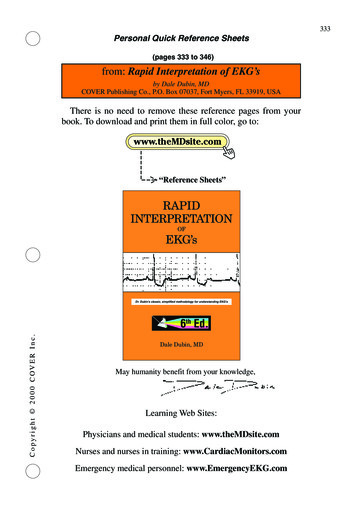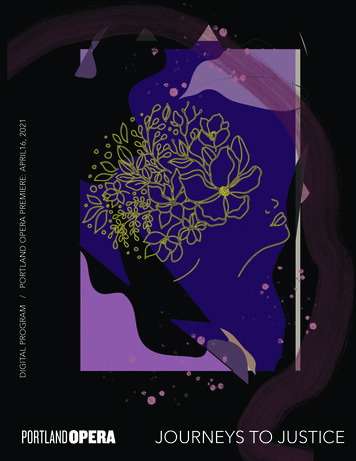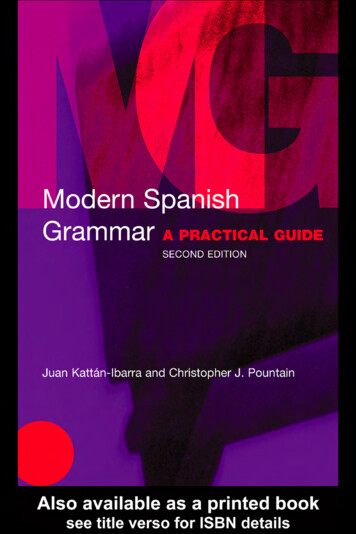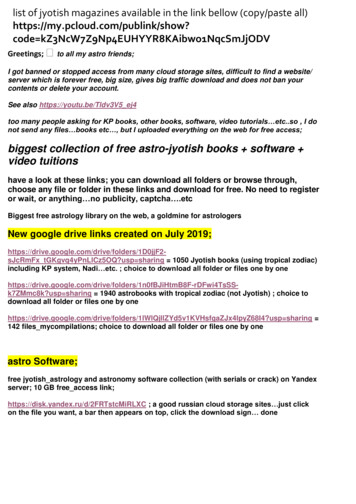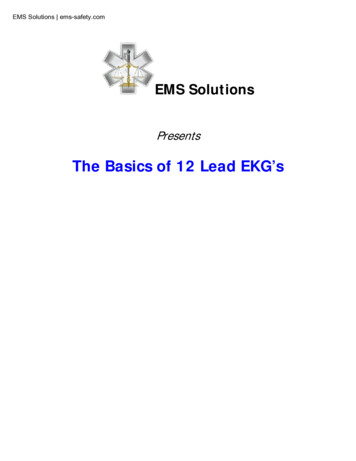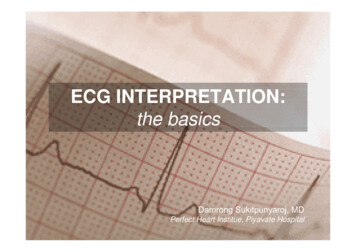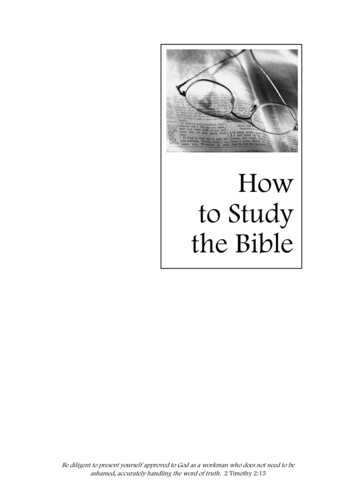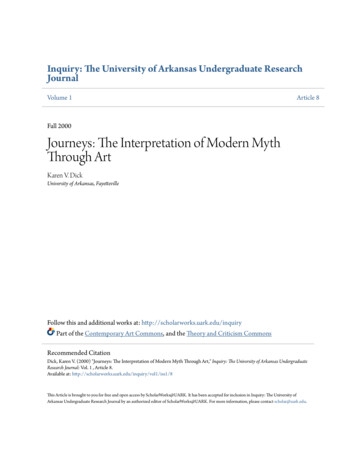
Transcription
Inquiry: The University of Arkansas Undergraduate ResearchJournalVolume 1Article 8Fall 2000Journeys: The Interpretation of Modern MythThrough ArtKaren V. DickUniversity of Arkansas, FayettevilleFollow this and additional works at: http://scholarworks.uark.edu/inquiryPart of the Contemporary Art Commons, and the Theory and Criticism CommonsRecommended CitationDick, Karen V. (2000) "Journeys: The Interpretation of Modern Myth Through Art," Inquiry: The University of Arkansas UndergraduateResearch Journal: Vol. 1 , Article 8.Available at: is Article is brought to you for free and open access by ScholarWorks@UARK. It has been accepted for inclusion in Inquiry: The University ofArkansas Undergraduate Research Journal by an authorized editor of ScholarWorks@UARK. For more information, please contact scholar@uark.edu.
Dick: Journeys: The Interpretation of Modern Myth Through ArtKAREN V. DICK: Journeys19JOURNEYS:THE INTERPRETATION OF MODERN MYTHTHROUGH ARTby Karen V. DickDepartment of ArtFulbright College of Arts and SciencesFaculty Mentor: Marilyn NelsonDepartment of ArtAbstract"Journeys" primarily investigates the interpretation ofone form ofexpression to another; i.e., the visual interpretationof myth through an in terms of the contemporary individual'spsychological voyage. The basis for this study comes from thewritings ofnoted scholar Joseph Campbell and others who placemyth in the position ofthe inward, not the outward journey in thequest for human discovery. As Bill Moyers so eloquently statesin The Power of Myth. "myths are the stories of our searchthrough the ages for truth,for meaning,for significance. We allneed to tell our story and to understand our story. " Thisresearch project is reali::.ed in its final form as a body ofcreativeworkfor exhibition purposes. It is ofsignificance to note that forartists, the exhibition ofcreative research parallels the publicationof written research in other fields. The project is an outgrowthof my past work and as a logical extension of that work, thisinvestigation demonstrates a relevance to an in a historicalcontext, as well as an exploration ofcontemporary artistic andintellectual activity.Kilren Dick and Marilyn NelsonHistorical OverviewMyth has a long history of interpretation in art, servingas a vehicle for the conveyance of information. According toGardner's An Through the Ages, one of humankind's greatestfeats, the ability to abstract, to make images and symbols, findsits origins in prehistoric cave dwellings, where Paleolithic manwas able to ftx in place the world of his experience. It is widelyspeculated that the cave paintings could have functioned in amythical manner possessing magical meanings for their fartthroughouthistory, yet it is usually seen in the context of the literal; i.e., theancient adventures of mythological creatures and personae withallegorical references to mankind's journey in the external sense.Published by ScholarWorks@UARK, 2000As man and technology have evolved. so has myth. Science hasdisproved many of the literal places and figures of the ancientstories, but the function of myth remains no less important. Aswritten in The Intellectual Adventures of Ancient Man, H. andH.A. Frankfort note that the imagery of myth "is nothing lessthan a carefully chosen cloak for abstract thought. The imageryis inseparable from the thought. It represents the form in whichthe experience has become conscious."The impact of myth on man has probably been mostfully explored by Joseph Campbell who spent a lifetimeinvestigating the commonality of theme in world myths and theirresonance in the search for human consciousness. In fact, the1
Inquiry: The University of Arkansas Undergraduate Research Journal, Vol. 1 [2000], Art. 820INQUIRYVolume 1 2000journey of the hero in myth reflects the journey of every man. AsCampbell states in The Hero with a Thousand Faces,"not the animal world, not the plant world, not themiracle of the spheres, but man himself is now thecrucial mystery."The inner world of the psyche and the unconscious,especially the nature of dreams, was explored in the early 20thcentury by the Surrealist art movement. Surrealism, however,was founded in the basis of composing without any preconceivedsubject or structure. The element of chance, randomness, andcoincidence became the basis for intensive study by the Surrealists.Although myth as a theme was more widely investigated byartists from the early ages through the 19th century, the subjectis not relegated to works of the past. Contemporary artists ofsignificance, notably Anselm Kiefer, are intermingling themythological with the real to explain or interpret the nature of themodern world. Kiefer, who is described by art critic RobertHughes as "the best painter of his generation on either side of theAtlantic," often uses mythic events as signposts to present hisviews of physical and human events. My research seeks tocreatively explore my concept of modem myth-the adventureof the individual into the unconscious and how that journeyparallels that of the ancient tales. For proponents of myth likeCampbell, myth serves in the role to reveal a deeper reality andallows man to experience that reality.BackgroundMy research into the journey of the individual began in1998 with a multi-part series, Passage:Rejlection. This projectexplored the issues of the transformation of the written word toa visual statement. Text, in the form of poetry, functioned as thebasis for the series. The poem was written during a transitionalpassage of my life, and while self-realization was the motivationfor writing, the search for self became the catalyst for artisticexpression. The primary question investigated was how could awritten work be visually stated without losing the identity or themeaning of the words? The objective of the artistic work was notto illustrate the text but to restate the written word in the form ofa visual vocabulary, retaining the emotional and psychologicalsense associated with the poetry.The project resulted in a 10 print exhibition series. Eachpiece of artwork dealt with a particular passage of the poem. (SeeAddendum 1). The prints were digitally printed and relatedformally and conceptually through development and technicalproduction. Traditional photography and digital processes wereemployed to integrate image and text into a "visual language,"designed to reflect the complex layering of the psychologicalbeings that we all ss1/8The Concept and FormAs a student of art history, I have been interested forsome time in the study of myth in art. My exploration into theinner self in my previous project in conjunction with a historicalconcern led me to the current investigation. The concept ofinterpretation plays a defining role in several aspects of thisproject. For Joseph Campbell, myth can function as a type ofguidepost for the individual in the interpretation of his own lifeexperience. "Anybody going on a journey, inward or outward, tofind values, will be on a journey that has been described manytimes in the myths of mankind." My objective is not to illustratestories, but to translate the psychological sense of the inwardjourney. A point of investigation is how to visually interpretancient mythology in terms of my own emotional response andmy concept of the modern individual's experience. The journeyis not the ancient's trek to an unknown land but the individual'squest into the unknown part of his mind.An approach utilizing painting, photography, and digitalimaging is employed. Conceptually, all three mediums havesignificance to this project. Painting is the oldest of the threepresent since the cave dwellers time.lt might be considered the"original" form of abstraction since it was the method in whichPaleolithic man represented his place in the world. Artistically,it is also the most "direct from the hand" of the three workingmethods used. The historical context of painting is relevant to theexploration of myth of all ages, and the directness ofits applicationis important to my interpretation.Photography provides a working visual vocabulary.The photograph has the unique ability to reference our experienceof the world in a direct manner. In the Museum of Modern Art· sexhibition catalogue, Thinking Print, it is noted that photographypossesses that special ability to create narrative subject matter,suiting the desire to reconnect art and life. Photography is anespecially powerful medium for communicating meaning oremotion, and on a conceptual level, photography is the referencingmedium for modern man.The use of digital imaging in concert with painting andphotography is especially important. The digital process allowsfor the creation of imagery often not possible in other mediums.The computer is rapidly changing the face of art, and it hascertainly become a standard working tool for artists. My workoften involves the transformation of the recognizable into theabstract. For this project, such transformation is analogous to thejourney of the individual from the external to the internal world.The computer also allows for the integration oflanguage into art.The language selected has relevance to ancient myths whosethemes relate to the contemporary individual, thus reinforcingthe parallels of the past to the present.2
Dick: Journeys: The Interpretation of Modern Myth Through ArtKAREN V. DICK: JourneysTechnical DevelopmentMy approach to the technical development of "Journeys"remains multi-disciplinary as with my previous work; howeverthe conceptualization of my ideas dictates that I expand mythinking into new areas within the digital imaging field. As adigital artist! amrathernon-traditional because I use the computerin an interpretive manner. The majority of artists working in thisformat are interested in creating special effects, thus allowing thecomputer and its unique capabilities to become less of a meansand more of an end. I view the computer simply as anotheravailable tool, much like a pencil, pen, or paintbrush.In my earlier series, the final production pieces arephotographically based, and although highly transformed, thework retains a strong sense of the photographic image. (SeeAddendum 1). Because of my objective to integrate painting intothe digital process, I have challenged myself to develop theimages in "Journeys" in a painterly manner. By expanding myearlier techniques to include direct photographic scans of suchsubject matter as my hands, I can translate the work to a newform. An unusual juxtaposition of imagery occurs through thismethod. The "real" three-dimensional object, a hand, loses itsidentity as an actual entity to become a symbolic image throughelectronic means.The image is actually "built" in the computer rather thantransforming an existing one, which is very similar to constructinga painting on a canvas. The colors are all mixed in the computerinstead of selecting standardized hues from a software program,and each piece has been digitally painted and drawn upon tocreate the final image. When text is used, it is layered into thepiece as an element of composition while retaining its identity formeaning. Once the image is constructed, traditional painting ordrawing techniques may be added as the final application,resulting in a mixed-media piece of art.The final works measuring 25" x 25" are printed on fineart canvas specific to this process. One of the most significantdevelopments in digital art is the relatively recent introduction ofarchival inks which are employed throughout this work. Whendigital imaging processes are presented for exhibition, it isessential to maintain image color and stability through the use offine art archival products developed for long-life application.Long-life products, although expensive, have rapidly expandedthe exhibition potential for digitally produced work.Project Significance"Journeys" has many areas of significance for mepersonally and professionally. The project is the culmination ofa SILO Undergraduate Research Fellowship, which was initiatedoutside of course work. The research is fully realized in a bodyof creative work for exhibition, which is one of the principalavenues available to the professional development of an artist, asPublished by ScholarWorks@UARK, 200021the public display of visual work is equivalent to the publicationof an author's written work in other fields.This research incorporates the various areas of my study asan artist with a multiple media approach. As a Bachelor of FineArts major with a concentration in graphic design and painting,I have challenged myself to use the tools normally associatedwith these mediums in very non-traditional manners. My objectivein doing so is to create work that is unique unto itself. In otherwords, the works do not have an obvious digitally imagedappearance. In fact, a measure of success for me can be measuredin the form of a question. If the viewer questions the medium asto print or painting, then I have achieved my goal of establishingthe process of digital imaging as a means and not an end.My choice of subject matter for this research offerscontemporary significance. We now live in an artistic environmentwhere pure visual content is integrated with personal, emotional,intellectual, and social content. We are in the Postmodem erawhere the impulse has shifted from strictly style toward thedirection of meaning. As curator Deborah Wye observes inThin/.ing Print, the new art world generation will be "using theword 'strategy' as opposed to 'style' to describe an artist'sapproach. Strategy implies a complex fabric of thinking andplanning." New questions in art include not only "what does thework look like," but "what does it mean?''Our exploding world of technology provides an appropriatebackdrop to the individual's search for internal meaning, and thisadventure is and always has been worthy of artistic investigation.To create a body of work through the most technologicallyadvanced methods, while attempting to connect us to the mostbasic mysteries of human experience, provides a rich field forexploration. This research is designed to challenge my thinkingin all of these areas; to create art with visual and emotive content;and to develop work that reflects a personal and universal appeal.Hopefully, this work serves as a testament to my personal as wellas creative journey.It seems to me that the only way in which an artist canmake his work durable and great is by seeking toarrive at the most direct expression of somethingactually felt by himself as a part of his own, and so apart of all human experience.Edward CarpenterAngel's rthEdition.HarryN.Abrams,Inc. New York.1998.Campbell, Joseph. The Hero with a Thousand Faces. Princeton University Press. Princeton, New Jersey. 1973.Campbell, Joseph. The !Y1a.sks of God: Primitive ,\fythology. Penguin/Arkana Books. New York. 1991.Campbell, Joseph. The Masks of God: Occidental Mythology. Penguin/Arkana Books. New York. 1991.3
Inquiry: The University of Arkansas Undergraduate Research Journal, Vol. 1 [2000], Art. 822INQUIRY Volume 1 2000Campbell, Joseph. The Masks of God: Creative Mythology. Penguin/Arkana Books. New York. 1991.Flowers, Betty Sue., Ed. The Pcr.verofMythwith Bill Moyers. Doubleday.New York. 1998.Frankfort, Henri,Frankfort, H.A., Wislon,JohnA.,Jacobsen, Thorkild.,Irwin, William A. The Intellectual Adventure of Ancient Man. The University of Chicago Press. Chicago. 1977.Norman, Dorothy. The Hero: Myth/Image/Symbol. New American Ubrary. Cleveland, Ohio. 1%9.Rosenthal, Mark. Anselm Kiefer. Philadelphia Museum of Art. Philadelphia. 1987.Segal, Robert A. ]OS 'Ph Campbell: An Introduction. Penguin BooksGroup. New York. 1997.Tansey, Richard G. and Kleiner, Fred S. Gardner's Art Through the Ages.Harcourt Brace College Publishers. Orlando. 19%.Wye, Deborah. Thinking Print: Books to Billboards 1980-95. The Museum of Modem Art. New York. Harry N. Abrams, Inc. New York.19%.Examples from the series: ''Journeys: The Interpretationof Modern Myth Through Art''25'' x 25'' Digital Images on CanvasSubtle RealityThe place or, medium of realization is neither mindnor matter, but that intermediate realm of subtlereality which can only be adequately expressed by thesymbol. The symbol is neither abstract nor concrete,neither rational nor irrational, neither real nor unreal.'''!tThe LAlryrinth. we have not even to risk the adventure alone, forthe heroes of all time have gone before us. The labyrinthis thoroughly known.We have only to follow thethread of the hero path, and where we had thought tofind an abomination, we shall find a god. And wherewe had thought to slay another, we shall slay ourselves.Where we had thought to travel outward, we willcome to the center of our own existence. And wherewe had thought to be alone, we shall be with all theworld.Joseph iss1/8The Still PointAt the still point of the turning world. Neither fleshnor fleshless; Neither from nor towards; at the stillpoint, the dance is, But neither arrest nor movement.4
Dick: Journeys: The Interpretation of Modern Myth Through ArtKAREN V. DICK: JourneysAnd do not call it fixity, Where the past and future aregathered. Neither movement from nor towardsNeither ascent nor decline. Except for the point, th still point, There would be no dance, and there is onlythe dance.T.S. EliotThe Story-TellerThe depths of the human soul are also "PrimordialTimes" . For Myth is the foundation of life; it is thetimeless pattern, the religious formula to which lifeshapes itself, inasmuch as its characteristics are areproduction of the Unconscious. There is no doubtabout it, the moment when the story-teller acquiresthe mythical way of looking at things . that momentmarks a beginning in his life.Thomas MannFaculty Comments:Ms. Dick's faculty mentor, Associate ProfessorMarilyn Nelson, made these comments about her projectThe Interpretaticm ofModern Myth Through Art, Karen'snewest creative, a series oflarge scale digitally printedimages, extends her work into the intellectualconceptualism of the modern myth, a subject ofuniversal significance for the modem artist.Contemporary artists often strive to integrate purevisual information with emotional, intellectual andsocial content. Having researched ideas presented byJoseph Campbell and others relative to myths, andtheir parallels to the journey of modern man, shevisually translates the psychological and emotionalPublished by ScholarWorks@UARK, 200023sense of the inward journey. This creative quest forself-discovery, Karen believes, functions in both theindividual and universal sense.This research is significant for several reasons. 1) Itsmulti-disciplinary realization of conceptsjuxtaposing and layering her photographs,typography, symbols and color selections anddepicting personal as well as universal characteristicsand concerns-is timely and important within therealm of contemporary art. 2) This research assumesa multi-disciplinary, non-traditional approach byincorporating photography, painting, and digitalimaging. All three media have conceptual significanceto the project. 3) The utilization of the computer as aworking tool is significant in today's art world asdigital images have become accepted as a valid formof art. Karen demonstrates an unusual use of this tool.Where most artists are interested in the effectsproduced by the computer, Karen is interested indiscovering creative uses of software to realize herconcepts, to juxtapose her photographs, typography,and color selections to depict expressivecharacteristics. 4) This sustained and concentratedeffort producing high quality work is ambitious andunusual for an undergraduate art student.In her paper, Karen's understanding of her creativeconcepts and the media employed for visualization ofsuch concepts is defined in a clear, concise, andorganized format. To translate the creative processinto writing is a struggle for many artists, but Karenhas a strong conceptual and visual reason for eachsymbol, image, texture, shape, and techniqueincorporated within her digital images. Thisunderstanding of the work does not inhibit thepossibilities of spontaneous discoveries during theworking process, but provides a knowledgeablebackground contributing to the ability to discuss thework. The mythological and historical basis, alongwith the contemporary applications of her work isalso well defended.Publication of Karen's paper in Inquiry: The UniversityafArkansas Journal ofUndergraduate Research is a ived.Karen's ability to articulate and defend her creativeresearch won her two prestigious undergraduateawards during the last year. She received one of sixuniversity wide Undergraduate Excellence in ResearchAwards at the University of Arkansas, Fayetteville,and a statewide SILO Advisory Council'sUndergraduate Research Fellowship (SURF). Thesetwo research papers resulted in two bodies of digitalprints reflecting concepts unique for each series ofimages. Fmally, Karen has already demonstrated herability to successfully formally propose and completean extensive research paper and project.5
Inquiry: The University of Arkansas Undergraduate Research Journal, Vol. 1 [2000], Art. 824INQUIRYVolume 1 2000Donald Harrington, Professor of Art History, had this tosay about Ms. Dick's work:Karen was ideally suited to undertake this work, notonly because of her superior talents as painter,photographer and art historian, but also because ofher deep interest in modem interpretations of myth.Mythology, which preoccupied artists from ancienttimes through the 19th Century, has been largelyneglected by modem artists, although the great myths,particularly those having to do with the idea of ajourney, have so much to say to any contemporaryartist in search of a significant theme.Karen Dick is not an art history major, but she hastaken every possible course that I have offered in thesubject over the past five years, and she has farsurpassed her peers in each of those classes. HergradesinmyclasseshavealwaysbeenA-plus.Indeed,I would go so far as to say that in my forty years as anart history teacher, I have never known her equal, letalone anyone more devoted to the subject. Herindependent research paper, dealing with pop artistJasper Johns' treatment of the American flag, remainsthe single best paper ever submitted in art history atthe University of Arkansas.Kristin Musgnug, Associate Professor of Art, wrote aboutMs. Dick's work as follows:Karen is one of the most outstanding students in theArt Department, and her project is distinguished forits intellectual depth and artistic mastery. Not only isshe gifted artistically, buttheseriousnessofherinquirymakes her a role model for other students. This is aprojectsuitableforexhibition, which in the field of art,is the equivalent of publication.The project is a thoughtful and sophisticated onewhich connects new technologies in art making withone of the oldest and most enduring expressions ofhuman culture. Like many art media, computergraphics programs are relatively easy to learn butcliffficult to master. Karen draws on extensiveexperience with these media and her work is ofprofessional quality.is a large subject to tackle, but it is also a lyexciting and intellectually demanding. Karen is thatrare art student with both artistic and intellectualDepartmental Chairman, Michael Peven, also praises Ms.Dick's efforts:I've known Karen as a student in our Art Departmentfor the last 3 years. While here, Karen has shownexceptional promise as an independently-mindedartist with a strong commitment to the creation ofmeaningful works. Karen has also exhibitedremarkable energy and enthusiasm in her pursuit ofthe B.F.A. degree, taking on numerous extramuralprojects for the department and others as adjunct toher regular course of studies. These are invariablyrewarding and mutually benefit Karen with furtherprofessional types of experiences and the clients whoreceive superior quality artistic designs, posters,announcements and other works. Karen isexceptionally creative and intellectually robust, asmanifested in the works that she ingwitha body of creative works for exhibition purposes,describes her interest in the interpretation of myththrough art and the relationships she hopes to drawbetweenmodemandancientmyths, which she definesas theadventureoftheindividualinto the unconscious.Karen's work deals with both written text and visuallanguage in order to translate the psychological andemotional sense of the inward journey she intends toillustrate. This project is tremendously interestingand challenging. Karen's desire and need to realize itthrough the combination of photography, paintingand digital imaging technologies makes it not only asuitable and worthy venture into artistic expression,but one that simultaneously explores the myths of artmaking itself, thereby adding another intellectualdimension to her pursuit. Karen is an exceptionalartist and student of art. This project is an exciting andvaluable addition to the contemporary dialog in thefield and one that is fully deserving of supportKaren's investigations take her to the forefront ofwhat is happening in art today, utilizing some of themany possibilities offered by electronic media. Use ofthe computer is transforming the art world, and I amexcited and pleased to support the work of a studentin this area. The field of contemporary art isincreasingly dominated by artists who move freelyamong various media, not confining themselves tojust one or two. Combining the media of painting andphotography with digital imaging test)fies to Karen'sabilities to think creatively across the range of mediaI also strongly support Karen's ambitious choice ofsubject matter. The mythic journey of self- /iss1/86
Dick: Journeys: The Interpretation of Modern Myth Through ArtKAREN V. DICK: Journeys25AddendumlFog Has Cut the PassageFrom the series, Passage:ReflectionFour Color Digital Image19" X 13"Published by ScholarWorks@UARK, 2000Deeper Into NothingnessFrom the series, Passage:ReflectionFour Color Digital Image19" X 13"7
of myth through an in terms of the contemporary individual's psychological voyage. The basis for this study comes from the writings of noted scholar Joseph Campbell and others who place myth in the position of the inward, not the outward journey in the quest for human discovery. As Bill Moyers so

